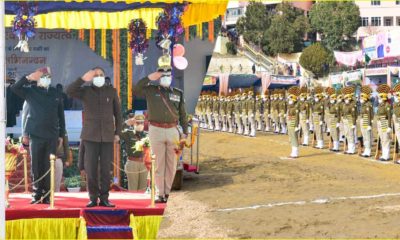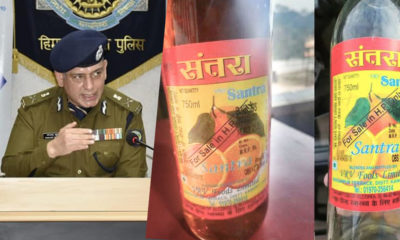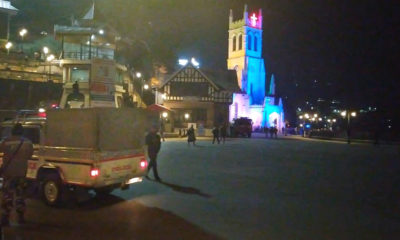HW Community
Cyber crimes flourishing in the State, HP Police stands helpless

A person lodged a FIR complaining that the FB account of his spouse has been hacked and being misused by the anonymous culprit. However, HP Police showed their inability to have any means of dealing with this complaint.
Along with writing to Mark Zuckerberg, what else would you do if someone hacks your Facebook account and starts misusing it; go to the police? That’s what a guy did when FB account of his spouse was hacked last week by some cyber miscreants. Unfortunately, the couple wasn’t smart enough to have written immediately to FB support asking them to deactivate the account, rather ran to the Police station, as any victim of a violation would do. However, HP police surrendered, as they haven’t been trained to tackle Internet related crimes.
Here is the story from the beginning. On 28th of last month, the husband of the victim, a local resident of Sumerhill, approached the Boileauganj Police Station with his complaint that was forwarded to the Sumerhill Police station on 30 November. When the complainer approached the station asking action on his complaint, he realized, the HP Police too, was helpless, as they barely know anything about ‘Cyber Crime’. Rather, one of the policemen told him that we don’t even have a computer in the stations, hence, it’s in vain to have any hope for some action in such a case . The police consoled him saying, “Here, in our departments, we doesn’t have trained & skilled personals to handle this sort of job ”.
As soon as the complainer wrote to us, we asked him to write to FB immediately. However, we too wondered as to what department we should forward the complaint. A state with a high rate of literacy is so backward in terms of IT education. How the Himachal government, itself living in darkness, aims light the path for the public. Why the vision of our policy makers is so limited that they couldn’t see the apparent culture of growing cyber crimes inspite of witnessing enormous cases of cyber crime all around the globe. While the world shops from home, HP Police haven’t got even computers at their stations.
As a ray of hope, now HP police has realized the need of a branch that would deal with the growing trends of cyber-crimes. A few days ago, State Police Vigilance, IG, Ashok Sharma admitted that due to lack of skilled manpower, the cyber crimes are suddenly growing unchecked. The establishment of a cyber crime lab has been proposed in Shimla, where trained police personals would deal with the challenges posed by cyber criminals, ensuring a effectivelyimplementation of the Cyber crime Act in the State.
However, we fear, the HP government is already far behind in the online race to tackle the cyber crimes and the time it would take to set a lab and train the official, adds to the distance. At the national level, the police and courts are even confused about the Section 66-A of the Information Technology (IT) Act. The arrest of two Mumbai girls for a comment and a like on FB, which was a big misuse of the act, is the hottest ongoing debate.
On the behalf of the public, we would like to poke the government and say, “wake up guys and try to keep up with the world. IT education and Internet are two most necessary facilities without which the true development of the State cannot be achieved.”
We are forwarding the copy of the grievance to the IT department and SP Shimla Police. We would update the status regarding the same as soon as we receive a reply.
How To Keep Your FaceBook Account From Being Hacked
The message also contained a tiny link to a pornographic video.
Turns out he didn’t send the message. His Facebook account had been hacked.
If you have received a similar message through Facebook or MySpace and you clicked on the link you may have been exposed to a virus and your social site is subject to being hacked.
Other messages may read,
“your name” sent you a message.
Subject: hey
Woww! Is thhat reallly you in thaat videoo?
or
“Hey, I have this hilarious video of you dancing. Your face is so red. You should check it out”
Have you experienced unauthorized activity in your facebook account? Has it been hacked by someone you do not know?
How To Avoid Being Hacked on Facebook.
In this Notes, I’m going to tell you how your facebook account is hacked and how to KEEP IT FROM being hacked. This information could save you a lot of problems in the future, not to mention the embarrassment of sending out elicit links to your friends and family.
How FaceBook Is Hacked
The main way your Facebook account is hacked is by someone obtaining your password.
Hackers gain unauthorized access through fake apps or website links. This is commonly know as phishing.
When you click on a link to a Web site which looks identical to the Facebook log-in page you automatically enter your username and password. The hacker now has immediate access to your account. Now all he has to do is use his newly found credentials (yours) to log in and send a personal message to all of your friends. When your friends click on the link he gains access to their accounts also.
Hackers can also gain access to your Facebook account by retrieving your saved passwords from your browser. They send out emails that contain malicious software embedded in them. If you open the email, you send your information back to the hacker.
If you”re a moblie phone user you may also be susceptible to hacks since in some countries the network signal is not encrypted. The hacker can possibly enter into the data stream that flows between the mobile and mobile operator and gain access to all of the information that you are sending out.
Facebook Viruses
Since most hackers use sophisticated software to place a virus on your computer once it’s hacked I am including a small amount of information about Facebook Viruses-
The “Koobface” virus- This virus comes through an e-mail sent by one of your social networking site friends inviting you to view a video.
Just don’t open any tiny links to videos that you don’t know anything about and you’ll avoid being exposed to this virus.
PC World has an article outlining more details to the “Koobface” virus. “
The Bredolab Virus- According to mxlab, the email includes downloadable files which include the trojan virus: Bredolab. If you receive an email requesting a “Facebook Password Reset Confirmation” email you should delete it right away.
A sample email may look like this:
Hey (your name), Because of the measures taken to provide safety to our clients, your password has been changed. You can find your new password in attached document. Thanks, The Facebook Team
Imitating official emails is a standard method for spammers. Always avoid downloading email file and attachments. For more information on the Bredolab virus you may want to view this article: New Bredolab Virus Targets Unsuspecting Facebook Users
More information on How Facebook Viruses work.
I also found an article called Beware of Facebook Virus by KDVR FOX 31 Denver Newsthat tells how a malicious virus can affect your computer if your interested in more information about what a Facebook virus can do to you computer.
Has Your FaceBook Account been Hacked?
How To Keep Your Facebook Account from Being Hacked
Now that you know how your Facebook account is hacked and about Facebook viruses , I’ll cover a few steps to take to avoid having your account hacked.
1. Protect Your Password and Secret Answer
Remember, the most common cause of account hacking is by obtaining your password.
Is your password easy to remember?
Here are a few ways to protect your password:
Change your password to something with numbers, letters, and/or special characters (if you can).
Don”t make it too easy to guess. Don’t use your pet’s name or your birthday.
Don’t Trust anyone, No exceptions, don’t tell your password to ANYONE, including your friends.
How To Protect your “secret answer”:
Birthdays and Pet’s names are not the best secret answers. A great approach is to realize that there’s nothing that says your answer actually has to correspond to the question, so pick an unrelated answer that has nothing to do with you.
Maybe you can use something off the wall for your birth date such as “mayonnaise”. As long as you can remember it, it doesn’t matter what it is.
You may even consider using another password to protect your password.
Change your password every month or so to ensure that even if someone did figure it out, they will have to figure it out again to access your account.Consider getting an alternate email address. It’s easy to set up anther account using gmail , hotmail, or some other online service especially for passwords.
Consider using a special service or software to protect your passwords. I useLastpass. It’s free and it also includes a password generator.
2. Avoid using Facebook Apps you are unfamiliar with.
One of the great things about Facebook is the access to all the applications. It’s nice to have fun, but don’t trust all the invitations for apps that you don’t know anything about. That’s why Facebook always asks if you want to give permission to access a new application.
3. Don’t fall for password recovery schemes or fake emails.
If you receive an email that asks you to change your password, delete it.It’s that simple.
I almost never click on links that are in my junk folder because my gmail account does a pretty good job of filtering fake emails.
You will never be taken to some random site unless you click on a fake link.
When you simply open a fake e-mail you will send your private details to a hacker. Don’t open emails you are unfamiliar with. Once opened, the damage already has been done.
4. Take precautions using mobile apps.
If you use a mobile phone application to access your facebook account check to make sure the signal is encrypted.
In the Unite States most operaters use an encrypted signal but be aware that other countries may not use a protected wireless signal. To avoid any problems always check with the mobile carrier you are accessing.
5. Finally, Change Your Facebook Password Today
I just changed my Facebook Password today since I figure this article will make me a target for a Facebook hack. You may want to do the same. Just use the advice that I included in this article. You may consider installing Lastpass or one of the other password organizers listed under “P” on my internet business resources page to aid you in forming a secure password.
Do you have more advice about how to keep your Facebook Account from being hacked?
If you have more advice on how to keep your Facebook account from being hacked please let everyone know using the comment form below. If you found this article helpful I’d also appreciate your comment below.
Information Source: FaceBook
HW Community
PIL Filed in HP High Court Re-Ignites Quest for Recognizing Pahari (Himachali) as Hill State’s Official Language

Shimla- November 10, 2021, Himachal Pradesh High Court on Monday passed an order concerning a public interest litigation (PIL) seeking to recognize Pahari (Himachali) as an official language of the state. The petition also sought effective steps on the part of the government to preserve and promote the Pahari language in the State as its culture and language give it a distinct identity.
The Public Interest Litigation was filed by Arsh Dhanotia with a prayer that the state be directed to declare Pahari (Himachali) as one of the official languages in the State of Himachal Pradesh in any script and also promote further research towards a long-term formal Pahari (Himachali) nuclear language structure and nuclear Tankri script.
Bhawani Pratap Singh Kutlahria, the advocate for the petitioner, argued in the court that the State Government be directed to promote Pahari (Himachali) and other local languages as the medium of instruction in primary and middle-level schools as per the New Education Policy, 2020. On behalf of the petitioner, he also prayed the court to direct the state government to include Pahari (Himachali) language as a separate category for the 2021 Census and simultaneously undertake an awareness campaign to create awareness amongst the masses, especially the youth of the State who speak Pahari (Himachali), to get it marked as their mother tongue in the upcoming Census.
A bench of Chief Justice Mohammad Rafiq and Justice Sabina while disposing off the PIL stated,
“The direction as has been prayed for, cannot be issued to the State Government until and unless it is established on record that the Pahari (Himachali) language has its own script and that a common Pahari dialect is spoken throughout the State of Himachal Pradesh. We, however, set the petitioner at liberty to approach the Department of Language Art & Culture to the Government of Himachal Pradesh with his demand for undertaking research to promote a common Pahari (Himachali) nuclear language structure and nuclear Tankri script. If the petitioner approaches the respondents-State through its Additional Chief Secretary (Language Art & Culture) to the Government of Himachal Pradesh) for the prayer made in the Civil Writ Public Interest Litigation, it would be for the said authority to consider the same in accordance with the law.”
Additionally, the petition had emphasised that Sanskrit, which is the second official language of the state, had only 936 speakers according to the 2011 census and Pahari (Himachali) dialect chain which is spoken by more than 40 lakh people was being neglected and has not been made an official language even after having so many speakers.
The petition also highlighted works of Former Chief Minister Late YS Parmar and Former Education Minister Late Narain Chand Parashar towards the promotion of the Pahari (Himachali) language.
What’s Pahari (Himachali) Language, How Many Districts It Covers
It is to be noted that according to the petitioner, Pahari (Himachali) is a combined term used for the Western Pahari dialect chain spoken in Himachal Pradesh and majorly includes Kangri, Mandeali, Chambeali, Kulvi, Mahasu Pahari and Sirmauri. According to him ever since the creation of Himachal Pradesh, there has been a demand for recognition of Pahari (Himachali) under the Eighth Schedule of the Indian Constitution and it is also officially listed with 37 more languages as a language which is in significant demand to be included in the scheduled languages category.
In his plea, he also stated that the Himachal Pradesh Vidhan Sabha in 1970 and 2010 have also passed resolutions concerning the promotion and development of Pahari (Himachali).
Environment
Himachal’s Snow Covered Area Has Decreased, Poses Big Threat to State Economy’s Lifelines: Report

Shimla-The area under snow cover in Himachal Pradesh has declined by 18.5% according to a recent report published by State Centre on Climate Change (SCCC) and Space Application Center (ISRO) Ahmedabad. The report revealed this decreasing trend for the five major river basins in the State.
As the report points out, the high altitude regions of Himachal Pradesh receive precipitation mainly in the form of snow during the winter season. One-third of the geographical area of the state is covered by a thick blanket of snow during the winter season. Rivers like Chenab, Beas, Parvati, Baspa, Spiti, Ravi, Sutlej and its tributaries flowing through Himachal are dependent on snowfall in winter. These rivers mainly feed into the Indus water system and a decline at this rate rings a death knell for water and also food security for millions of people from Himachal to Kashmir, the plains of Punjab, the food bowl of the country.
Using images and data received from satellites, the report states, that the winter precipitation was mapped in all the basins from October 2020 to May 2021 (a period of two years). The findings indicate that there has been an average decrease of 8.92 percent in Chenab basin, 18.54 percent in Beas basin, 23.16 percent in Ravi basin, 23.49 percent in Sutlej basin compared to last year. The ice covered area of Chenab basin was 7154.11 sq km in 2019-20, which has come down to 6515.91 sq km in 2020-21. Similarly, Beas basin was reduced from 2457.68 to 2002.03 square kilometer, Ravi basin from 2108.13 square kilometer to 1619.82 square kilometer and Sutlej from 11823.1 square kilometer to 9045 square kilometers. Overall, the snow covered area was reduced from 23542 square kilometer to 19183 square kilometer in the entire Himachal.
Sutlej Basin covers 45 per cent of the total geographical area of Himachal and it is the longest river of the state. It flows for around 320 kms here, passing through Lahaul and Spiti, Kinnaur, Shimla, Kullu, Mandi, Solan and Bilaspur districts, along its course. The above study shows that the maximum reduction in snow cover has occurred in the Sutlej basin. An area of 4359 square kilometers under snow cover has decreased for the whole state, of which more than half of the Sutlej Basin.
Just two years ago another study had indicated that more than half of glaciers in Sutlej Basin are set to vanish by 2050. Yet another study also showed that the Sutlej basin has the highest 562 number of glacial lakes. These lakes stand the risk of sudden outbursts, which then causes flash floods downstream as the valley has already experienced. So, while the crisis that is unfolding, be it deglaciation, lake formation or reduction in area under snow cover, it seems that the Sutlej river basin is more vulnerable to these changes.
Prakash Bhandari, an environmental researcher and activist and member of Himdhara Collective expressing his concern states that the situation in the Sutlej river basin is certainly indicative of a serious climate emergency and it is critical to look into the drivers of this both local and global.
“The Sutlej basin catchment is the largest and so the changes visible here are more significant. Many factors have worked together to create this crisis which should be studied closely. There is no doubt that global warming is contributing to these changes. But the local conditions also play a role in reducing or increasing its impact”, he says.
The upper reaches of the Sutlej Valley, especially areas like Kinnaur are geologically fragile, with sharp gradients and loose soil strata. Vegetation is in a very small area so the proneness to erosion. We have seen the catastrophic impacts of flashfloods and landslides over the last decade and a half, where crores worth of property has been damaged. This year saw a spate of landslides where lives were lost. “In such a sensitive and also strategically important area, changes in the landscape will have far reaching and irreversible impacts. More construction activities will lead to more deforestation, more erosion”.
Construction of dams has been rampant in the Sutlej valley, a phenomena that started post independence and continues today. If all of the planned dams are built the Sutlej will be cho-a-cloc with more then 150, large and small projects. At the bottom of the valley in Bilaspur is the Bhakra Dam, built almost 6 decades ago, which has a size of 168 sq km and a storage capacity of 9.340 cubic km. Is. This is followed by the Kol Dam which extends for 42 km up to Sunni, which has a total storage capacity of 90 million cubic metres. Nathpa Jhakri Project which is 27.394 kms. is long. When a dam is built, a huge amount of water is stored. The debris of many villages, trees etc. also gets absorbed inside the dam. When water is stagnant, it receives heat from the Sun to form mist in the surrounding area by evaporation and simultaneously generates methane gas. The experience of the lake formed by the Kol dam at Tattapani in Mandi district shows that the area is experiencing heavy haze which was not there earlier.
“In the 30s and 40s, Shikari Devi and Kamrunag used to have snow on the peaks for about 6 months, which now could barely stop for only 2 months. The air route distance of Shikari Devi and Kamrunag is only 26 to 30 kms from Tattapani lake. At the same time, their distance is not much from the cement factories of Darlaghat, Sundernagar”, the elders in the area say. “Today, fog is prevalent and this has also made the area warmer”.
Due to the warming of the weather due to the clouds formed from the mist, the snow has started melting quickly. Apart from this the local crop patterns are affected. Post the 1990s, the Sutlej became a site for run of the river hydroelectric projects using extensive underground tunneling. This involves massive use of explosives for blasting through the mountains. Of the 23,000 MW worth of projects to be constructed in Himachal more than 10,000, a third are from this valley alone. Kinnaur continues to be a hydel powerhouse with 10 run of the river projects in progress and 30 more to be set up including two mega projects of 1500 MW and 1000 MW each. This paints a scary picture.
Interactive Sutlej River-Basin Map indicate Hydropower Station location
It is not just the hydro-electric dams but unplanned tourism and other development activities like mining, cement plants, road expansion and mindless construction across the high Himalayan regions have also add to the shift in local weather patterns, land use changes and thus the ecological crisis. But the reason why we should put the limelight on hydropower is that this is being pushed as “Green Energy”, in the name of climate change mitigation. As opposed to other forms of generating power, hydropower projects are said to cause lesser carbon emissions, which is why there has been a global push to shift to renewable resources. But the climate emergency in the Himalayas has put a question mark on ‘water’ as a renewable resource.
The question then arises that with all this data indicating a steady decline in river discharge and snow cover have our planners and policy makers not considered what will happen to these projects? Will they be able to generate the power they propose to? The people of Himalaya have to wake up to this wastage of public resources. Scarce funds should be diverted to better planning for securing local livelihoods by protecting the forest ecosystems and water sources for the future.
Author: Gagandeep Singh-From Himdhara (Environment Research and Action Collective)
Feature Images: unsplash/@raimondklavins
HW Community
Himachal: Warnings of Delta Plus Virulence Fall on Deaf Ears, No Restriction on Visitors from Affected States

Shimla-Yesterday, the Centre government directed the state governments to take immediate measure in wake of the spread of more infectious Delta Plus variant. As the Delta Plus variant is posing a threat of the third wave, the states were told to take steps like preventing crowds, increase testing, more focus on surveillance, contact tracing and put boosting vaccine coverage on a priority basis. Following it, Himachal Pradesh Government might have announced an alert over Delta plus variant, but there wasn’t any follow up on instructions passed by scientists and health experts to take strict restrictive measures ahead of the impending third wave.
To make it worse, high rank officials and political leaders were seen flouting Covid-19 SOPs on several occasion, which sent wrong messages to the masses. The pictures and videos showing flouting of Covid appropriate behavior by Chief Minister Jairam Thakur and Directorial General of Police, Sanjay Kundu, alongwith other staff for Anupam Kher is the most recent to mention. A group photograph and video of the same were widely circulated on social media and invited huge criticism from the people.
So far, the state has not reported any case of the Delta Plus variant. But the neighboring states – Punjab, Haryana, and Jammu & Kashmir – reported their first cases yesterday. This puts the boarding areas, like in Una district, at a higher risk. Chief Secretary to HP Government, Anil Khachi, yesterday said samples have been sent for genome sequencing.
Despite repeated warnings of Delta plus variant (B.1.617.2.1.), Himachal Pradesh has thrown its borders open to all and lifted all restrictions for inter-state travel in just one go. From June 23 onwards, the state government removed the condition for registering on the e-pass portal for visitors intending to enter the state. In the Cabinet meeting held on June 22, 201, the government first decided that e-pass restrictions would be removed from July 1, but later it changed the decision and instead implemented it immediately.
This haphazard decision is said to have come under huge pressure from the hospitality industry – the worst-hit sector, leading to financial crisis and mass unemployment among its stakeholders. Related associations had been approaching Chief Minister Jairam Thakur with their pleas to provide relief, but mostly faced disappointment. The stakeholders say the state government didn’t provide any significant relief, which is making the survival of the industry difficult.
Also Read: Read Eight Reliefs That Himachal’s Devastated Tourism Industry Seeks from HP Govt
Also, stakeholder of the industry, especially hoteliers, had been demanding the removal of restrictions and conditions on the entry of tourists to Himachal so that they could fetch the remaining peak tourist season.
With its inability to offer relief, the HP Government took the chance to waive off restrictions in a haste.
At the same time, the state government has decided to conduct offline examinations for the undergraduate classes starting from July. A section of the students had been condemning the HP government for scheduling exams without vaccinating students. Some student bodies had been asking the government as to why online classes were possible but not online exams.
The state government also waived off restrictions on timings for the opening of markets/shops.
As scientists and health experts warn of the virulence of the new variant and with neighboring states already on alert after reporting cases of the new variant, the HP government hasn’t even mentioned any intention to at least put a check on the visitor from the states where cases of Delta Plus are being reported. Carrying an RT-PCR negative report for visitors from such states/cities would have been a wiser step.
Officially, the state is on alert, but no measures have been announced to check the entry and spread of the variant into the state. The state government does speak of preparing for the anticipated third wave, but there is hardly any long-term preventive strategy. The Covid appropriate behavior is hard to adopt when markets and tourist places are crowded with visitors.
Why Delta Plus is a Big Concern
The World Health Organization (WHO) has labelled the Delta variant as ‘Variant of Concern’.
The Centre and scientific/medical institutes in India also agree with that Delta Plus as a variant of concern and could be the cause of impending third wave. Last Tuesday, based on the findings of INSACOG, the Union Health Ministry had alerted and advised Maharashtra, Kerala and Madhya Pradesh regarding the Delta Plus variant of COVID19.
INSACOG had warned that the Delta Plus variant has increased transmissibility, stronger binding to receptors of lung cells, potential reduction in monoclonal antibody response.
“Delta variant is more resistant to medication, treatment and vaccination. Therefore, people who have been vaccinated can still be affected by this variant and can go on to get a clinical illness, Archana Dhawan Bajaj, director, Nurture IVF, told a national English Daily.
“Neutralising antibodies against this variant post-vaccination seem to be nearly five times lower in people who have already been vaccinated than the other variants,” she said.
Further, Dr Raman Gangakhedkar, ex-Head Scientist of Epidemiology and communicable diseases, ICMR, has also expressed concern over the reports that Delta Plus has reported pathophysiologic change and affecting different organs. Dr Raman says that it could transfer from cell to cell and would more likely produce neurological symptoms as a common manifestation.
So far India has reported 51 cases of the Delta Plus variant.
Delta Plus variant is a variant of Delta with an additional mutation -B.1.617.2.1.
















 Home Decor Ideas 2020
Home Decor Ideas 2020
